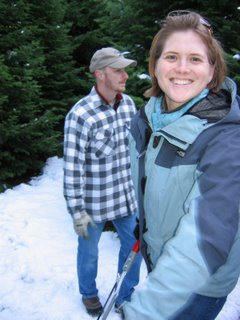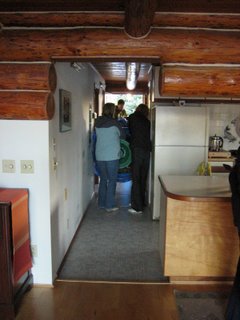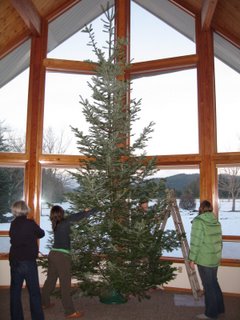With spring comes our annual "tradition" of tree-planting. This is our fourth year of planting, and we've definitely learned more each year. The primary lesson from last year's planting is to get it done quickly! The 1,200 trees that we planted last year took all of our free time from March to mid-June to complete. The combination of our late planting and an unseasonably hot and dry spring weather resulted in a terrible survival rate: ~25%. Yes, you read that right - that's the SURVIVAL rate, not the loss rate. 900 of the 1,200 trees that we planted in 2009 didn't make it. The Douglas Fir seedlings fared particularly poorly, even though they were the first to be planted and thus received more rain and had more time to acclimate before the heat and dryness of summer arrived.
This year was dedicated primarily to replanting the losses from the previous three years. We knew that we wanted to get everything done early, and preferably in a single shot. We estimated that it would take approximately 90-100 man hours of effort to finish the whole thing in one fell swoop. If we could find two additional planters and some Anders care, we figured that we could get the whole thing done in a four-day weekend with only 5-6 hours of field work per day. So we scheduled a long weekend around Easter and invited some family and friends to join us for hard work, good food, good company, and lots of laughing.
A week before the scheduled event, Anders came down with a cold. In the interest of not spreading it to all of our volunteers, we delayed the work weekend by one week. It's a good thing that we did, too, as we received one of the larger snowstorms of this mild winter. It would have been difficult to plant trees in 6" of snow.

We managed to enlist Reidar, Donna and Leif to join us, but another friend who was planning to help out wasn't able to make the rescheduled date. That left us one person short of our goal to complete the whole project in a long weekend. On a whim, we decided to ask Loren if he would be interested in a short jaunt from Tulsa to help out. Being the seat-of-the-pants type of person that he is, he agreed. But we kept his planned participation secret from the rest of the group.
The weather was much more cooperative when the rescheduled weekend arrived, and Anders had recovered sufficiently. Each of our volunteers had a specific role: Leif, Loren, Corinne and I would be the planters; Donna was chief cook, bottle washer and Anders watcher; and Reidar was on tractor repair, fence mending, and cookie delivery. First to arrive were Donna and Leif, driving from Seattle on Wednesday night. Thursday morning we began our work in earnest with Corinne, Leif and myself starting in the field while Donna stayed in the house to watch Anders and work the kitchen.
Since Leif and Loren require naps each afternoon in order to function properly (yes, that's right - two grown men can't function without daily naps!), we decided on a daily schedule that could accommodate: breakfast; 2.5-3 hours field work; lunch; nap; 2.5-3 hours field work; dinner. We finished the morning work period roughly on the desired schedule and headed in for lunch.
Meanwhile, Reidar was driving down from Tacoma and stopped to pick up Loren from the Portland airport. They arrived in Trout Lake around 1:30pm while Leif and Anders were down for their naps. And this is where the real scheming came in. I met Loren and Reidar out on the street and offloaded Loren into our machine shop. Reidar then continued to the house as if he had arrived by himself. Loren took a brief nap in the bed of the farm pickup in the shop.
After Leif's nap, I walked out to the planting field ahead of Corinne, Leif and Reidar, stopping by the shop to grab Loren on the way. I hid behind some older trees near the field while Loren started working in the field. The rest of the group arrived soon after, and as planned Leif initially assumed that I was the person working in the field. As he got closer - and particularly after I emerged from the trees next to him - it began to dawn on Leif that something was going on. Corinne told Leif that the extra person was the neighbor. Leif's final realization came when he got about 10 feet away: "That's my bro-.... that's that asshole from Tulsa!" Much smiling, laughing and hugging ensued. Then the real work commenced again while Reidar walked back to the machine shop, laughing the whole way.
The deception wasn't over yet, though; Donna still didn't know about Loren. When our work for the day was complete, Leif and Loren swapped hats and coats, and Leif hid outside while Loren went in with us and pretended to be his brother. It only took a few minutes for her to figure it out, and more smiling, laughing and hugging ensued.
Now that all of that monkey-business was out of the way, it was time to focus on the work. While the weather was much better than the previous weekend, it was still odd. On Thursday, it snowed and melted three different times, including some hail. But it never rained (very hard), and the temperature stayed nice and cool - good for both the young seedlings and the field hands. Since the Douglas Firs fared so poorly the previous year, we opted to make all 1,200 of this year's trees Ponderosa Pine.
Our planting is a two-step process. The ground first needs to be prepped - sometimes called "scalped" - to remove the grasses that would compete with the young tree for water and nutrients. Then that spot can be planted. With Reidar's help, we actually experimented with using a PTO-mounted auger to plant the trees, but it was overkill given the small size of the trees.

Scalp...

...then plant
We decided to make an instructional video to help illustrate the process.
Since we are all pretty fair-skinned, we all tried to cover ourselves to prevent burning. Leif's choice of hats some days was, uh, interesting.
Each day we repeated our eat/work/eat/nap/work/eat schedule, though we tended to start the days a little later each time. We did all of our menu planning, shopping and some of the cooking ahead of time, and Donna manned the kitchen, preparing and cleaning up after each meal.
The rest of the time she spent entertaining Anders - or perhaps it was the other way around.
We had prepared, and we had all of the help that we needed. Now we just had to execute. At the end of each work period, I recorded - via my Facebook account - how we were doing against our goal.
Tree planting, Day 1 of 4, break time: 250 spots prepared. Only 950 spots to go, and 1200 trees remaining to plant.
Tree planting, Day 1 of 4, end of the day: ~600 spots prepared, 600 to go. Friday: start planting!
Tree planting, Day 2 of 4, midday break: 400 of the 600 spotted prepped yesterday are now planted in Ponderosa seedlings. 600 more spots to prep, and 800 more to plant. For the project management types among us: we are exactly 100% on track to our plan. ;)
Tree planting, Day 2 of 4, end of day: a productive day today, 800 trees planted and a few prepped spots leftover for tomorrow. Only 400 trees remaining! We are now officially ahead of schedule.
Tree planting, Day 3 of 4, early morning: The soreness begins to set in. Each morning we're starting later and later. We hope to finish all of the planting today and keep tomorrow as a day of rest, but we'll have to see how our bodies hold out. And BTW - I am not talking about Farmville here. We are actually planting a REAL FARM. ;)
Tree planting, Day 3 of 4, midday break: Almost done! Prepped and planted another 300, leaving only 100 left to plant. We're still well ahead of schedule and will hopefuly be able to get in the "bonus" work of scalping the ground of all of the previous years' seedlings as well.
Tree planting, Day 4 of 4, morning: Finished! We planted all 1200 trees yesterday, and even managed to get a start on the weed and grass scalping around the trees from previous years. Unfortunately, even though we "finished" early, today is not a day of rest. We're fixing a fence post and then scalping more weeds and grass.
Tree planting, Day 4 of 4, midday break: fence fixed. (Yeah, I know it has nothing to do with trees.)
Tree planting, Day 4 of 4, end of the day: ALL field work done, including the re-scalps from all previous years. Yeah!
It was a pretty exciting moment when we finished planting all 1,200. Perhaps we got a little too excited.
Most of the trees that we lost in previous years just died, probably as a result of insufficient water. But we did find some that had been stepped on by wildlife or eaten by gophers. It was particularly annoying to find gopher damage to the three year old trees that we planted in 2007.

You can see teeth marks
In between work sessions, we had a great time entertaining ourselves. This was the first time in a long while that we had both of Corinne's brothers together, so we used the opportunity to quiz Anders on who was who. Amazingly enough, 80% of the time when we asked "Where is Uncle Leif?" or "Where is Uncle Loren?" he would point to the right person.
At one point during a dinner, Corinne was quizzing Anders on the sounds that various animals make. He got all of his "standard" ones right - cow, horse, sheep, goat, etc. We then tried a few that he didn't know, and he just stared blankly back at us. Uncle Loren asked one final question: "What does Anders say?", and without missing a beat, Anders answered; "CAT!" And of course, he was correct.
A week later, we actually planted a few more trees that were leftovers from our
local Conservation District's "Arbor Day Tree Giveaway" - 20 Western White Pine. And after that last 20, I really have no desire to plant anymore trees. Until next year, that is.
- Mike, Corinne and Anders Rocket



















































